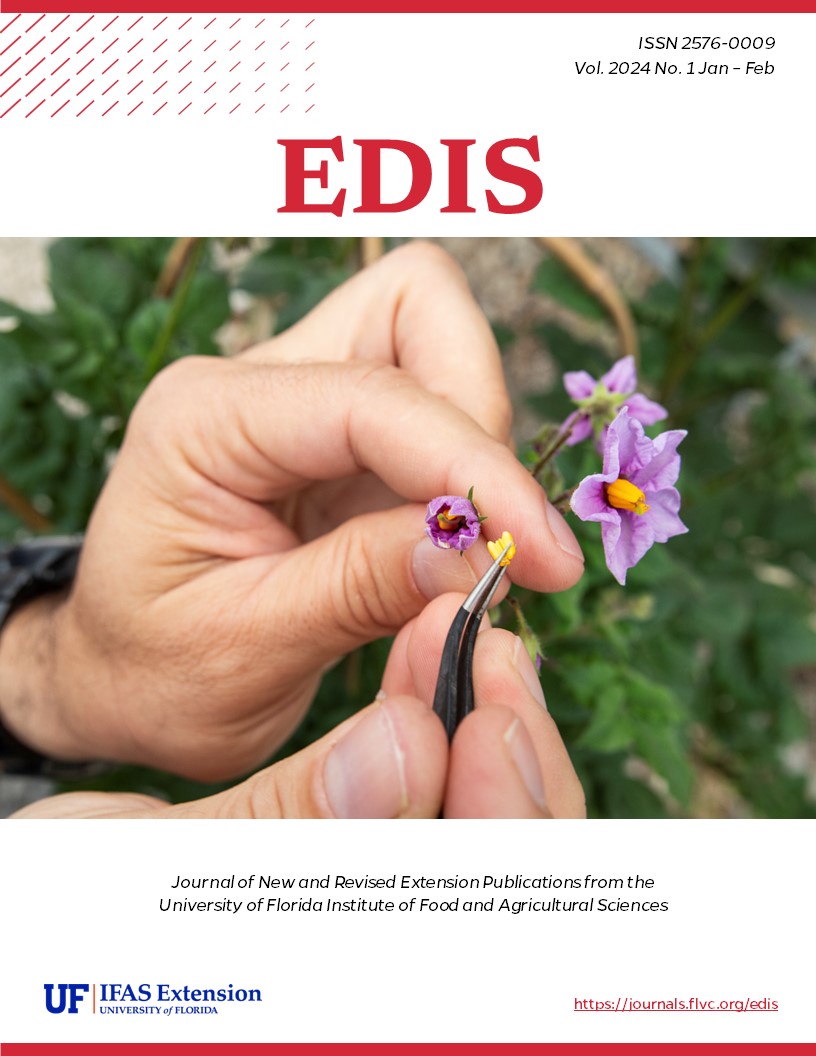Abstract
Aceria hibisci, the hibiscus erineum mite, is a mite in the family Eriophyidae and can be a pest on ornamental Hibiscus rosa-sinensis plants. Eriophyid mites are small worm-like mites that feed on plants by sucking out the cellular contents from leaves and stems. During feeding, they release chemicals that cause the formation of abnormal plant growths like galls and erinea. This mite species is not currently present in the continental U.S., but is established in several Pacific islands including Fiji and Hawaii, as well as Caribbean regions including Cuba, Puerto Rico, and Jamaica. Therefore, it is a species of concern with potential to become introduced and established in the continental U.S. This publication describes biology, diagnosis, distribution, and management of this mite species.References
Brown MS, Blubaugh CK, Chong JH. 2021. Biology and management of eriophyid mites in turfgrass. Journal of Integrated Pest Management 12: 25. https://doi.org/10.1093/jipm/pmab020
Dively GP, Hartman ME, Ochoa R. 2022. Population dynamics of eriophyid mites and evaluation of different management practices on Timothy Grass. Journal of Economic Entomology 115: 602-610. https://doi.org/10.1093/jee/toac004
Gabellini S, Scaramuzzi S. 2022. Evolving consumption trends, marketing strategies, and governance settings in ornamental horticulture: A grey literature review. Horticulturae 8: 234. https://doi.org/10.3390/horticulturae8030234
Guo J-F, Li H-S, Wang B, Xue X-F, Hong X-Y. 2015. DNA barcoding reveals the protogyne and deutogyne of Tegolophus celtis sp. nov. (Acari: Eriophyidae). Experimental and Applied Acarology 67: 393-410. https://doi.org/10.1007/s10493-015-9953-9
Hara A, Tsuda D, Tavares J, Yogi J, Hensley D. 2001. Hibiscus Erineum Mite. Insect Pests.
Jeppson LR, Keifer HH, Baker EW. 1975. Mites injurious to economic plants. https://doi.org/10.1525/9780520335431
Keifer HH. 1946. Eriophyid studies XVI. Bulletin for the Department of Agriculture of California. 35: 39-44. https://doi.org/10.1093/jee/39.5.563
Keifer HH. 1966. Eriophyid studies. State Bureau of Entomology, California Department of Agriculture. 22 pp.
Lindquist EE, Sabelis MW, Bruin J (Eds.). 1996. Eriophyoid mites: their biology, natural enemies, and control. Elsevier, Amsterdam. 790 pp.
Manson DCM, Oldfield GN. 1996. Life forms, deuterogyny, diapause and seasonal development. Eriophyoid mites: their biology, natural enemies, and control. Elsevier, Amsterdam. pp. 173-183. https://doi.org/10.1016/S1572-4379(96)80009-1
Marini F, Weyl P, Vidović B, Petanović R, Littlefield J, Simoni S, de Lillo E, Cristofaro M, Smith L. 2021. Eriophyid mites in classical biological control of weeds: Progress and challenges. Insects 12: 513. https://doi.org/10.3390/insects12060513
Michalska K, Skoracka A, Navia D, Amrine JW. 2010. Behavioural studies on eriophyoid mites: an overview. Experimental and Applied Acarology 51: 31-59. https://doi.org/10.1007/978-90-481-9562-6_3
Monfreda R, Nuzzaci G, Lillo ED. 2007. Detection, extraction, and collection of eriophyoid mites. Zootaxa 1662: 35-43.
Mua M, Joshi RC. 2014. Galling of the Chinese hibiscus (Hibiscus rosa-sinensis L.) in Samoa. Fiji Agricultural Journal 54: 54-58.
Nalepa A. 1906. Über zwei neue Eriophyiden den von den fidischiinseln. Journal of Economic Biology 1: 147-151.
Navia D, Duarte ME, Flechtmann CHW. 2021. Eriophyoid mites (Acari: Prostigmata) from Brazil: an annotated checklist. Zootaxa 4997: 1-152. https://doi.org/10.11646/zootaxa.4997.1.1
Oldfield GN, Michalska K. 1996. Spermatophore deposition, mating behavior and population mating structure. Eriophyoid mites: their biology, natural enemies, and control. Elsevier, Amsterdam. pp. 185-198. https://doi.org/10.1016/S1572-4379(96)80010-8
de la Torre P, Martinez H. 2004. Lista de los ácaros Eriofioideos (Acari: Prostigmata: Eriophyoidea) de Cuba. Revista Ibérica de Aracnología 9: 123-126.
Van Leeuwen T, Witters J, Nauen R, Duso C, Tirry L. 2010. The control of eriophyoid mites: state of the art and future challenges. Experimental and Applied Acarology 51: 205-224. https://doi.org/10.1007/978-90-481-9562-6_11
Welbourn C, Rodrigues JC, Peña JE. 2009. The Hibiscus Erineum Mite, Aceria hibisci (Acari: Eriophyidae) a new introduction in the Caribbean and a potential threat to Florida's hibiscus. https://doi.org/10.32473/edis-in777-2008
Williams DJ, Watson GW. 1990. The scale insects of the tropical South Pacific region. 3: The soft scales Coccidae and other families. CAB International, Wallingford. 267 pp.

This work is licensed under a Creative Commons Attribution-NonCommercial-NoDerivatives 4.0 International License.
Copyright (c) 2024 UF/IFAS

